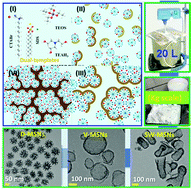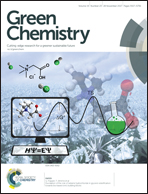A dual-templating strategy for the scale-up synthesis of dendritic mesoporous silica nanospheres†
Abstract
We have demonstrated a facile and green way to synthesize dendritic mesoporous silica nanoparticles (DMSNs) on an ultra-large scale (kg) with cetyltrimethylammonium bromide (CTAB) and an anionic surfactant as dual templates free of organic solvents. In contrast to its co-template role in tuning the packing parameter of the surfactant molecule organization, the anionic surfactant herein acts as a more strongly competitive counterion against the adsorption of negatively charged silicate oligomers (I−) on the micelles. Based on the new understanding of the interaction between the cationic–anionic surfactant ionic pairs and the silicate oligomers, we proposed a dual template synergistically controlled micelle self-aggregated model to understand the formation mechanism of dendritic MSNs where the anionic surfactant stabilized micelles or micelle blocks are basic self-assembling building units for the formation of center-radial pore channel networks. By using one-pot in situ isomorphous substitution, the metal Ti atom can be easily incorporated into the silica frameworks of DMSNs, and the obtained Ti-DMSN catalyst shows a superior catalytic performance in the epoxidation of cyclohexene over the typical mesoporous Ti-MCM-41 silicas.

- This article is part of the themed collection: 2017 Green Chemistry Hot Articles


 Please wait while we load your content...
Please wait while we load your content...